Over 30 years ago—in March of 1984—Hayao Miyazaki’s first original movie soared into theaters. This was Nausicaä of the Valley of the Wind, and it proved a watershed moment in the history of anime. Here was a film built around real thematic concerns, with a heroine who fronted an action movie without becoming an action cliché. Here monsters were revealed to be good, and humans were revealed to be… complicated. Here, Miyazaki created a film that would serve as a template for the rest of his career.
And maybe best of all, Nausicaä’s success led to the foundation of Studio Ghibli the following year.
Creating the Valley
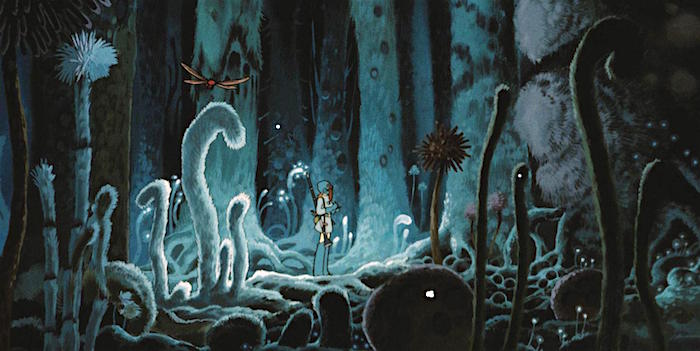
Toshio Suzuki, editor of the magazine Animage, was impressed by Miyazaki’s work on The Castle of Cagliostro. He asked Miyazaki to pitch ideas to Animage’s publisher, Tokuma Shoten, but when his film ideas were turned down, Tokuma asked him to do a manga.
Miyazaki began writing and drawing Nausicaä of the Valley of the Wind in his spare time in 1982, in addition to his work directing TV shows (including a few more episodes of Lupin the III) and the manga soon became Animage’s most popular story. Hideo Ogata and Yasuyoshi Tokuma, the founders of Animage, joined Tokuma Shoten in asking Miyazaki for a film adaptation, which he finally agreed to do if he could direct. Isao Takahata came on as a producer, but they needed to choose an animation studio. They went with a studio called Topcraft, hired animators for Nausicaä only, and paid them per frame.
The animators managed to create an iconic work in only 9 months, with what would be a $1 million budget today.
This was Miyazaki’s first collaboration with Joe Hisaishi, a minimalist composer who would go on to score all of Miyazaki’s films, as well as other anime productions, and many of the films of Beat Takeshi Kitano. (Joe Hisaishi actually based his stage name on Quincy Jones – since in Japanese his name would be written Hisaishi Joe, with “Hisaishi” using the same kanji as “Kuishi”, which is close to Quincy.)
Miyazaki’s Nausicaä (the character) is named for a character in The Odyssey, the daughter of Alcinous and Arete, who help Odysseus return home to Ithaca after his adventures. Nausicaä (the movie) was inspired by the tragedy of Minamata Bay. During the 1950s and 60s, Chisso Corporation’s chemical factory continuously dumped methylmercury into Minamata Bay. This resulted in severe mercury poisoning in people, dogs, cats, pigs, and obviously fish and shellfish, and the effects were named “Minamata Disease.” Even after it seemed the original outbreak had been resolved, Congenital Minamata Disease began cropping up in children over the next decade. There were thousands of victims over the years, and by 2004, Chisso Corporation had been forced to pay $86 million in compensation. This horrific incident inspired a great deal of activism and art, including this iconic photograph by W. Eugene Smith.
Obviously, that work focused on the victims, and the negative aspects of the environmental impact. Miyazaki took it in a different direction by exploring an environment that adapted to the poison. Much like the Japanese kaiju films of the post-World War II era that used silly rubber suits to comment on the horrors of nuclear weaponry, Miyazaki used manga, and later anime—both seen as frivolous entertainment—to comment on the destruction of the natural world.
The interesting thing to me is that Miyazaki took a horrific injustice that is know throughout Japan, and chose to look past the immediate tragedy. He commented that his imagination sparked because, since no one would fish in the Minamata Bay anymore, sea life there had exploded. He became interested in the way Nature was adapting to the poisons that had been dumped into the bay, and rather than retelling the story of the human horror, he focused on the way nature synthesized the poison and bounced back. He created an entire world that had been poisoned so he could look at the way humans’ toxicity warped the Earth, and the way the Earth healed itself.
Story
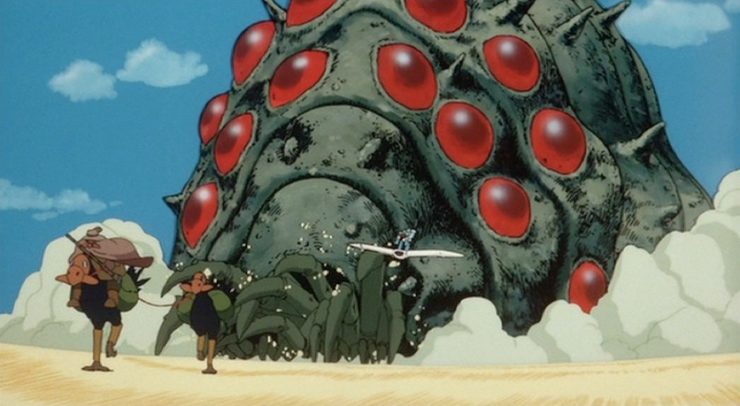
Nausicaä of the Valley of the Wind takes a sliver of the manga and runs with it. Nausicaä is the Princess of the Valley of the Wind. The Valley is one of the only fertile areas we see in the film, but its close proximity to the Acid Lake and the Sea of Decay put it in constant danger. Spores from the Sea of Decay—a massive toxic forest—would destroy the crops, but usually the winds keep them at bay. Life in the Valley is peaceful, but there are dark undercurrents: Nausicaä’s father is wasting away from his years of exposure to toxins, and there are rumors of war surrounding the Valley. In addition to human danger, there are massive insects called Ohm that will kill people who get too close to their young—in the film’s first action sequence, Nausicaä rescues her friend, Lord Yupa, from a pissed off Ohmu.
Life in the Valley is shattered when a massive plane carrying the Princess Lastel of the Pejite people crashes near the village. The people haven’t even finished burying the dead (including the Princess) when the warlike Tolmekians show up. They are led by another Princess, Kushana, who has to use mechanical legs and an arm after being maimed in an insect attack. Her men kill Nausicaä’s father, subjugate the people of the Valley, and claim that the Pejite cargo, a massive bioweapon called a God Warrior, will be finished in the Valley and used to destroy the Ohmu.
Nausicaä is caught between wanting to protect her people and save the Ohmu, especially after she discovers that there’s more to them than most people think. The Tolmekians take her hostage, the Pejite attack, and she gains an unlikely ally in Lastel’s brother, Asbel. All the conflicts come to a head when Lord Yupa, Asbel, the Pejite people, the Tolmekians, and Valley people face an army of Ohmu who are enraged when a gang of Pejites kidnap and torture one of their young.
Warriors of the Wind
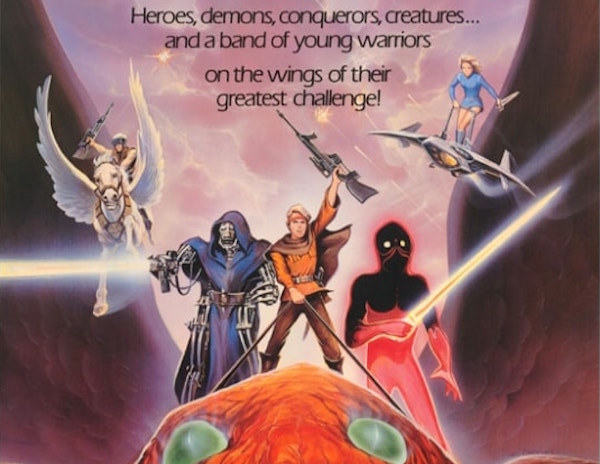
In 1985, Nausicaä of the Valley of the Wind came to America. But because we can’t have nice things, New World Pictures (Roger Corman’s production/distribution company, which, to be fair, at least gave us Heathers) were the ones who brought it over. Thinking Americans couldn’t handle a complex environmental fable, they chopped Nausicaä to bits and re-edited the film to turn the Ohmu into exactly the “relentless killing machine” cliché that Miyazaki was subverting. They deleted over 20 minutes of footage, including the introduction to the Sea of Decay, Nausicaä’s secret garden—which explains that there is pure water beneath the earth—and Nausicaä and Asbel’s journey beneath the Sea of Decay—which reveals that the plants are filtering the poison from the world, and that the Ohmu are guarding it. It also cut Nausicaä’s role down in general, and, as you can see in above, slapped a bunch of nameless male “protagonists” into the promotional art.
This utter mangling of a heartfelt piece of art led to Studio Ghibli’s “no cuts” policy going forward, which is why it took a while for many of their films to come to the U.S. (According to rumor, when the Weinsteins planned to edit Princess Mononoke, an unnamed Ghibli producer sent them a katana along with a note reading: “No Cuts.” I desperately hope this is true, and that that producer got a raise.) It wasn’t until John Lasseter was in a position of power with Disney that he and Ghibli brokered a distribution deal for their films.
Nausicaä’s Legacy
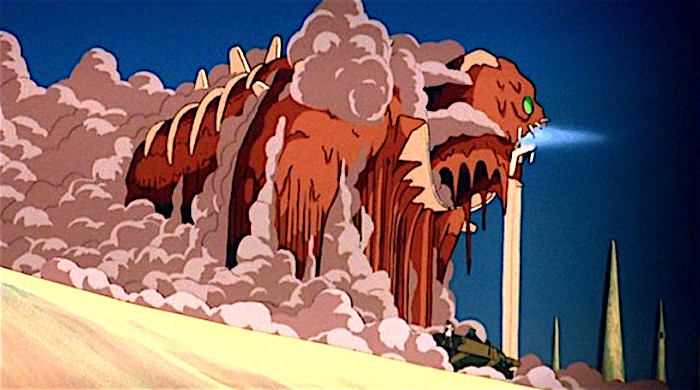
The most obvious legacy of Nausicaä is that soon after this film’s success, Studio Ghibli was born. After twenty years of work together, Hayao Miyazaki and Isao Takahata teamed up with producer Toshio Suzuki and Yasuyoshi Tokuma of Tokuma Shoten Publishing to create a new studio with its own personality and ethos.
One of my favorite bits of trivia that I learned during this rewatch is that Hideaki Anno was the main animator on the “God Warrior” sequence (above). Anno went on to create the iconic Neon Genesis Evangelion, which is also about giant human/mechanical hybrids created to defend earth from monsters. He also did a live-action take on the God Warrior sequence for the Ghibli Museum which you can watch here. And over thirty years later, Miyazaki asked Anno to voice the main character in The Wind Rises.
Another fun thing that Nausicaä contributed to the culture: the giant, ostrich-like Horseclaws are riding birds based on the long-extinct Gastornis. These affectionate creatures supposedly inspired Final Fantasy’s beloved Chocobo.
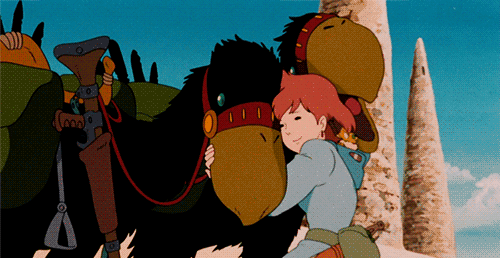
Who Run the (Post-Apocalyptic) World?
Miyazaki—in his first original film—populates the world with complex women in order to subvert the message of a centuries-old folktale. Along with the tragedy of Minamata Bay, the 12th-century Japanese tale “The Princess (or Lady) who Loved Insects” is often cited as an influence for Nausicaä. This story is about a Heian-era girl who loves playing with bugs. This is sweet at first, but as she gets older her family and the other women of the court become increasingly critical of her. She refuses to wear makeup, to blacken her teeth, to enter into the usual court intrigues, and most problematic, she has no interest in being courted. But this doesn’t seem to be a cute story about an oddball who finds happiness with her insect friends—instead it seems much more like a didactic folktale, reminding women that their value lies in beauty and conformity.
Miyazaki takes that seed and grows a beautifully unique tree. Nausicaä does what she wants, not because she’s a spoiled princess, but because she is truly interested in learning more about the Sea of Decay.
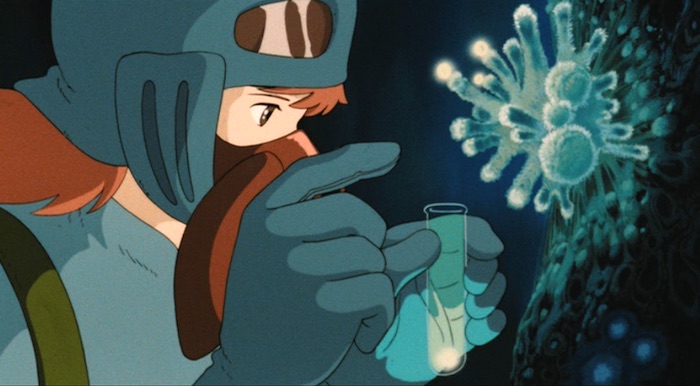
When she finds Ohmu shells she shares them with the villagers. She treats all the people of the village as her equals. She helps fix windmills, she plays with the kids, and you get the sense that Lord Yupa is not the first hapless traveler she’s rescued from an Ohmu. Her interest in the Toxic Jungle, which could be an eccentricity in a lesser story, becomes the source of hope for her people when she realizes that the Earth is healing itself.
Best of all, it’s not just her. As enraging as Princess Kushana’s behavior is, she’s not a cardboard villain. Even after surviving an insect attack, she willing to listen to the Valley’s Wise Woman, Obaba, and to Nausicaä; Kushana isn’t subjugating the Valley of the Wind to be cruel. Obaba herself is afforded complete respect from everyone. The women of the village work just as hard as the men, and hope for their daughters to be strong like Nausicaä. Best of all, when Nausicaä is imprisoned by the Pejite, it’s the other women who rescue her. Asbel tells the women the truth, but they’re the ones who work out an escape plan and choose to substitute one of their own to dupe the guards. Lastel’s mother leads Nausicaä through a room of women who all wish her well and encourage her to save her people—a network of people considered too unimportant to be closely watched, who save the person who saves the world.
Redefining the Monstrous
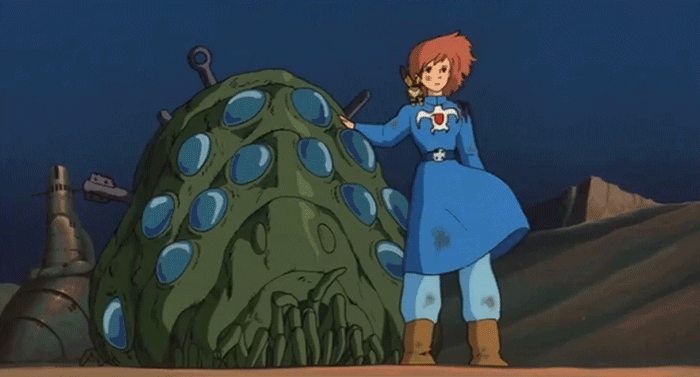
Nausicaä is a post-apocalyptic adventure tale that subverts every cliché it finds. The obvious would have been to pit Nausicaä against a man: the empathetic, caring woman fights an angry, warlike man through the power of love. But Miyazaki sidesteps that trope by creating a complex female antagonist. Kushana is much more assertive than Nausicaä, but she was also maimed in an insect attack, and understandably does not see the Ohmu as anything to make peace with, and she genuinely wants to unite the people of the world in order to reclaim Earth from the insects. In a different story, she’d be the hero. Most interesting, even after she has subjugated the people of the Valley, she still wants to sit down and discuss Nausicaä’s theories about the Sea of Decay and the Ohmu’s role in the world.
But Miyazaki has an even bigger subversion in store. Nausicaä appears to be building up to a final confrontation between several different furious worldviews. The Tolmekians, the Pejite, and the Valley people are all coming together to a battlefield beside acid lake, while the Ohmu charge toward them. Kushana has her God Warrior, the Pejite have a gunship, the Valley people are waiting in hope that Nausicaä is coming back to lead them.
But that isn’t what happens.
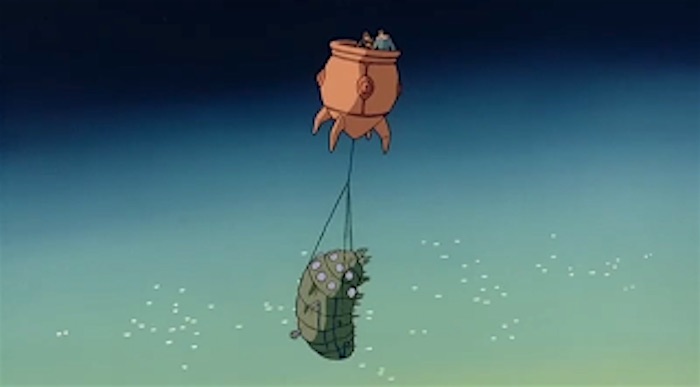
When Nausicaä sees that the Pejite people are torturing a baby Ohmu to incite an insect stampede, she leaves her people and veers across the Acid Lake to rescue the baby. She literally sidesteps the battle, and changes the meaning of the film. This is not a war story. It is not a clash of civilizations. It’s a film about listening to Nature and redefining the monstrous. The people who tortured the baby Ohmu are monstrous. The people who would revive the God Warrior are monstrous. And rather than engaging in a dialogue with them, Nausicaä resets her priorities and goes to do the thing only she can do: save the baby Ohmu, and calm the insect herd.
When the film starts, we see an intricately designed tapestry that seems to tell a prophecy. We see a man investigating a village destroyed by poison. We get long panning shots showing us the weird beauty of the post-apocalyptic terrain. And then? We meet our heroine Nausicaä, who wanders through the forest unafraid, rejoices when she finds an intact Ohmu shell (her villagers can use the shell for all sorts of things) and pries one of its eye lenses up.
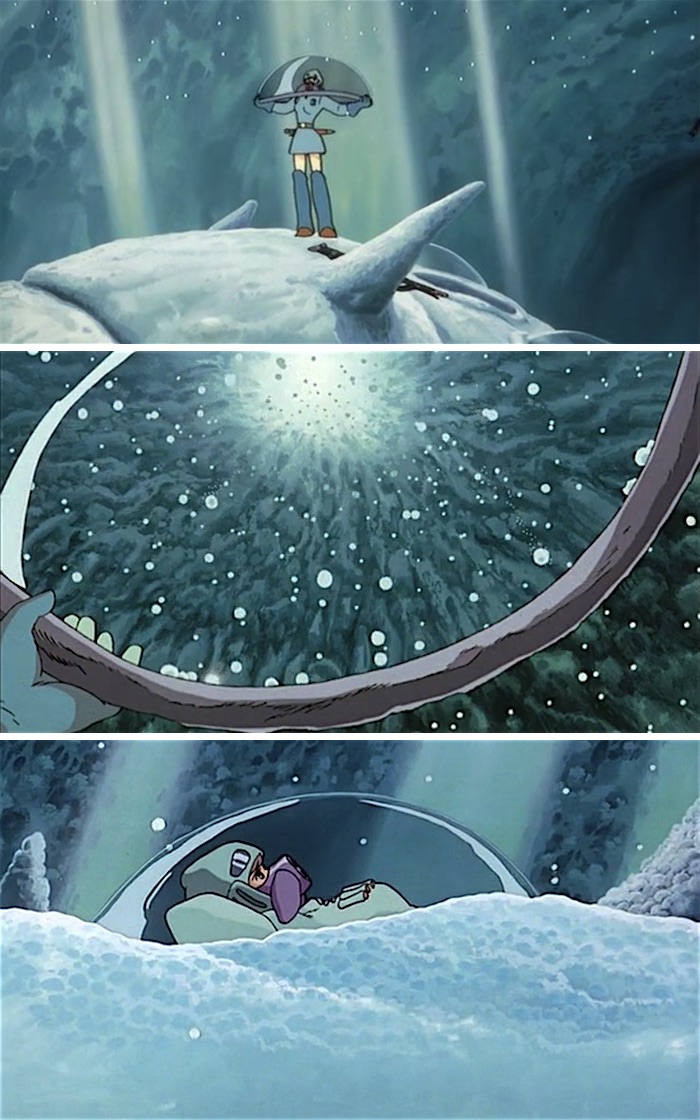
The first action we see our heroine take is to literally look at the world through the eye of a creature that most would call a monster. This is an extraordinary sequence, and Miyazaki allows it to play out with the confidence of a much more mature filmmaker. After all, this was only his second film, and his first original one, but he allows minutes to go by as Nausicaä lays on top of the shell and gazes at the forest.
It tells us almost everything we need to know about her in a few gorgeous images.
As we begin the film, we think of the insects as monsters, giants who can be blinded by rage. But they are protectors: they protect the “Sea of Decay” because beneath the poisoned forest the Earth is healing itself. All the insects can be reasoned with, all of them are sentient. Here Nausicaä is set apart from other people because of her immediate acceptance of other creatures. Rather than seeing a divide between human and animal, royal or peasant, she simply treats everyone the same. She loves the Ohmu long before she has any idea that they’re helping the forest. And of course, we get an early hint that they see her, too:
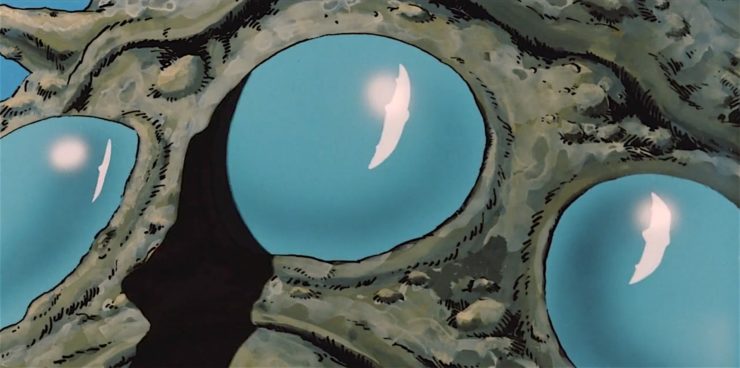
The movie presents the first Ohmu we see as a terrifying rage monster, and when Nausicaä hears gunshots and rushes to help, we assume she’s going to help the human, but no—she immediately assesses the Ohmu’s anger, decides that the human must have threatened its young, and takes action to calm the Ohmu down and lead him back into the forest, where he’ll be safe.
At the end of the film, when she rescues a baby Ohmu, she calls him a “good child” – which the subtitles on the DVD, and the dub of Warriors of the Wind changed to “good boy”. Now, while the phrase “good boy” has become a great honorific on the internet as memes praising doggos and puppers have proliferated, Miyazaki scholar Eriko Ogihara-Schuck pointed out in Miyazaki’s Animism Abroad that this is placing the Ohmu in the role of a domesticated animal, a role of servitude, where the film clearly does not see the Ohmu that way, and obviously Nausicaä referring to the Ohmu as a child puts the insect on a much more intimate standing with her.
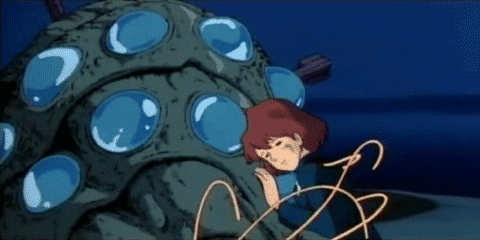
Nausicaä doesn’t care about the differences between humans, animals, insects, plants – they are all living creatures deserving of respect. Nausicaä is also considered especially gifted when it comes to wind, but here again, it’s because she listens. There’s nothing that special about her otherwise, she’s just willing to watch the wind and go where it takes her.
But there’s another aspect that’s important to mention.
She has to choose between her own animal anger and her instinct to act out of love and trust. When the Tolmekian soldiers murder her father, her rage is entirely justified, and it is darkly satisfying to watch her burst into the room and cut them all down. But at the same time, her rage would have led to the slaughter of her people; as it is, she injures Lord Yupa when he tries to stop her.
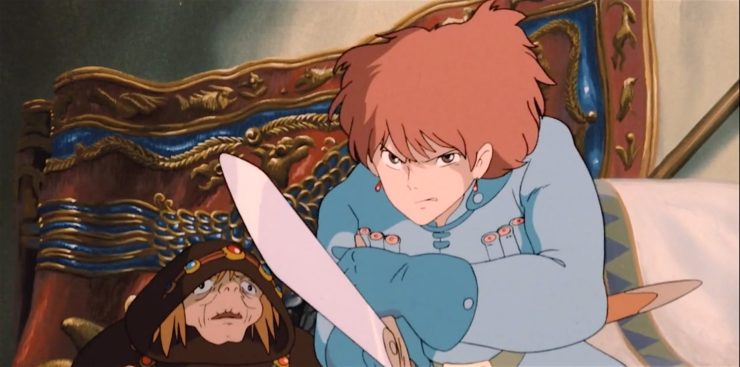
This moment is echoed years later in Princess Mononoke, when Ashitaka steps between San and Lady Eboshi—here again people must learn to transcend violence.
The last third of the film sees Nausicaä desperately trying to get home, to warn the villagers of the oncoming Ohmu attack. As soon as she sees that a baby Ohm is being tortured she changes tracks. She knows that Yupa and Mito can warn the village—but she’s the only one who can rescue the Ohm, and hopefully accomplish the much larger task of calming the herd of insects. Yupa, with all of his nobility and swordsman’s skill, is useless here. Asbel, who would be the hero in most adventure films, is now little more than a sidekick. Not even the wise old woman Obaba has cultivated the connection to the natural world that Nausicaä has. So she grabs her glider and veers left, racing to reach the Ohm. The Ohm is being flown by two men in a basket, who are guarding their captive with a machine gun. First they shoot at Nausicaä, then they mistake her for the dead princess Lastel.
She stands on her glider, either to startle them, or in the hope that they won’t shoot when they see she’s unarmed. But once they crash, Nausicaä will do what is necessary. She is no cute moe, like Clarisse in Cagliostro, or Kiki in Kiki’s Delivery Service. But nor is she a feral child like San, or a cold bitch like Kushana and Lady Eboshi. This is a woman who ignores the pain from two gunshot wounds to help the baby Ohm.
This is a woman who unhesitatingly threatens the Ohm’s captors with a machine gun to set it free.
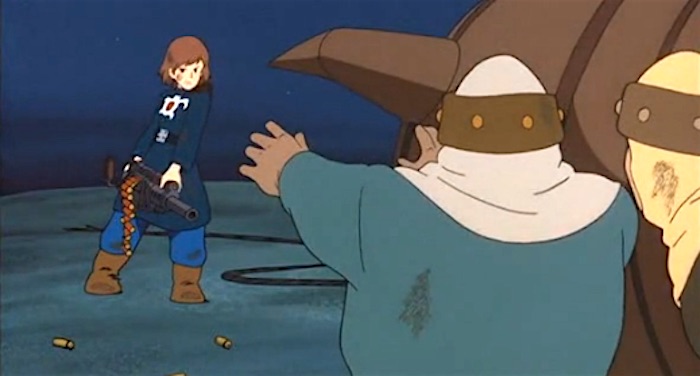
I have no doubt that she would have shot both of them for the chance to calm the Ohmu herd, and she would have felt terrible pain doing it, but she’s going to do what’s necessary for the good of her villagers, and the good of the Ohmu. She knows now that the Ohm are part of a larger design to save the world, and she’s not going to stop until they’re safe.
And naturally, it is this baby Ohmu, whom Nausicaä accepts as a child like any other, who saves her life during the stampede:
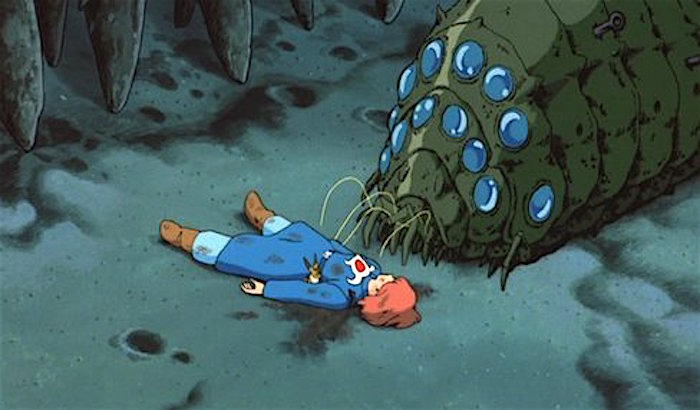
Nausicaä of the Valley of the Wind could have been a rote post-apocalyptic tale. Instead, Miyazaki created a film that is alive with ideas. The film merges a real-life tragedy with a centuries-old folktale to tell a subversive story of independence, intellectual curiosity, and, most of all, hard-won, life-saving empathy. Nausicaä created the road map for Studio Ghibli to follow, and soon Nausicaä and Asbel were joined by an army of smart girls and thoughtful boys, along with even more subversive monsters.
Leah Schnelbach wants an Ohmu of her very own! Come talk to her about post-apocalyptic super bugs on Twitter.










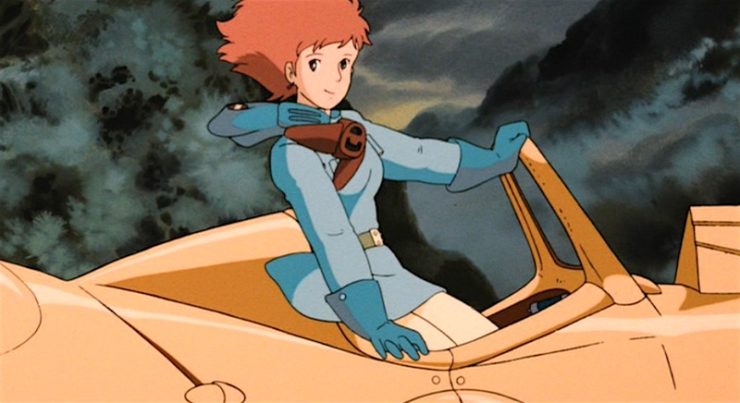
I love the manga and reread it every couple years.
For a long time I had heard their was a movie version but the references to it were very dismissive and made it seem that the movie was nothing like the comics. I now wonder if they were referencing the old cut version. Or that it was the “true fans” dislike of anything that is not a utterly faithful rendition of their beloved written work depicted on screen.
Either way thank you for showing that this is something I should seek out.
I really enjoyed this movie when I saw it (though part of me wishes there was an actual movie based on that poster for Warriors of the Wind. It’s like if Hasbro made a toy line for Jodorowsky’s Dune). For more anime with airships, I recommend the television series Last Exile.
Also worth noting: Yes, Nausicaa is in fact wearing pants throughout this film. However, due to color palette limitations while making the film, they just happen to be the same shade as her skin. I was surprised that this wasn’t something they fixed in subsequent home video releases.
@2 it’s been years since I’ve watched this, but in the photos above, the pants have a more yellow tone versus Nausicaa’s face which leans more toward pink. Maybe this was an old limitation of video tape that you saw?
I also see the comparison to Dune. It was my first thought as a teenager way back in the day.
I am totally in a meeting right now and I’m not able to read this article, but I just wanted to say Warriors of the Wind was my gateway anime. I caught the end on HBO as a child and cried and cried because of the girl trying to stop the bugs from going into the acid and the hurt baby bug and the bugs healed the girl. When I saw that crazy box cover in a video store I immediately realized what I was looking at and watched it an loved it and the same video store had Gaiking and Grandizer and Spacekateers aka Starzinger and that was it for me. Anime lover for life.
I love this movie so so so much. So much that I am totally making this post while in a meeting. Can’t wait to read the article.
Dang. No wonder this film made less of an impression on me than expected, if the American version I watched was missing so much of what made the original great. Still, I should watch it again despite the scariness of the God Warriors. Thanks for the reminder that it features some of my favorite fiction themes.
If I weren’t at work right now, I’d totally cry. I love this movie so much. Really great job talking about this movie from many aspects, much I haven’t read before. I’m totally going to read the Miyazaki’s Animism Abroad now, since on google it seems to be free. If anyone knows of any details books or blogs or articles about Studio Ghibli movies, please share in the comments. I don’t think I’ll ever get enough.
Would you consider reviewing the manga as well? I didn’t always full understand its events, and would love a deeper read.
Keep up the awesome articles.
Nausicaa remains my absolute favorite Miyazaki film, though I saw My Neighbor Totoro first when I was in grade school. It has so much depth, heart, and spirit; it’s a movie that earns your respect with every minute.
Also, because you asked: here is The Guardian interview where Hayao Miyazaki confirms the katana story is true.
In most of the Miyazaki films I’ve seen, a central protagonist and antagonist are complex, interesting, and female (if there are antagonists). Seems the pattern goes way back.
My first exposure to Nausicaa was in the early 90’s, via a $1.99 bargain-bin VHS tape of “Warriors of the Wind”. My wife and I had picked the tape up before attending a party, and it was quite late before we got home and popped it in, intending to watch just a few minutes out of curiosity before retiring. Needless to say, we were up very late that night. Even in that half-butchered form the seamless animation and Miazaki’s story telling and world-building drew us in. We’ve never looked back.
For the record, whatever its flaws, (and there are many) the WOTW cut had both decent voice acting, and a clever turn of phrase for Nausicaa’s glider, which was termed a “cloud-climber”. Nicely poetic, that.
That Warriors of the Wind poster looks terrible.
@8/AeronaGreenjoy: “In most of the Miyazaki films I’ve seen, a central protagonist and antagonist are complex, interesting, and female (if there are antagonists).” – And his protagonists always navigate a complicated and confusing world by being friendly and helpful. I love that.
On a more superficial note, I just noticed that in one respect Nausicaä is a typical 1980s SFF heroine: She has red hair.
I’ve always wondered about Nausicaä’s name. Is there any resemblence between her and the character from the Odyssey, or did Miyazaki simply like the name?
For those of you interested in reading more about Miyazaki’s movies and his thought processes on them, I suggest looking at “Hayao Miyazaki: Starting Point: 1979-1996”. It’s a compendium of a number of essays, interviews, letters, and articles Miyazaki wrote or has attachment to that tell a story of how Studio Ghibli was founded, and what formed his work process and personal life over the first half of his film-making career, as well as the things that made and influenced him in the years prior.
As great as this film is, (and it is great), it still pales in comparison to the manga. Princess Kushana in the manga is a magnificent character, bold, smart and charismatic, the inclusion of the Doroks and their emperor as well as the Forest People make for a truly astounding story.
Good article!
That Hideaki Anno was the animator of the God Warrior sequence appears to be a fairly well known bit of trivia in Japan. So much so, that the series Shirobako (an anime series about the making of anime series) features a character who is clearly meant to be an analogue of Anno and suggests animating a sequence in the same style as God Warrior.
I don’t have much to add to the article, most of the important stuff has been well covered, but I did want to express my appreciation for the “old men in a tank” sequence.
@10 JanaJansen: As for Nausicaa´s name, I´ve been thinking about it, and yes, there is a connection. Odyssey starts with young princess Nausicaa finding this guy near the beach: he looks like hell, and is naked, but for some reason she doesn´t run away screaming or something, but brings him clothes and invites him to dinner. At dinner, she learns he is actually an enemy: Odysseus from Ithaca, nearby island, and the relationships between her people and his are so bad that by revealing his identity he actually risks his life. But then he starts to tell this crazy tale about his long, long journey from war, and the tale has giants and witches and gods and monsters in it, and before the dinner is over, even Nausicaa´s dad, who has been seriously thinking about killing this guy at first, is so moved by the story he even borrows him a ship to give him ride home.
So… princess kind to strangers, even enemies, motif of shipwrecking/plaincrushing… doesn´t seem coincidental to me.
This is an excellent history and review of a wonderful film. Thanks for that. As others have commented Warriors of the Wind worked as a good gateway to anime, even butchered as it was. Reading the manga and seeing the original film decades later was a revelation. The manga is long and complex but truly excellent, I highly recommend it.
Warriors was also my gateway anime. However, as I recall, it did indeed include the under-forest scene, with the lake.
Sadly (?) I no longer have that, but have enjoyed the original many times over the years.
I still wonder where the heck the robot and pegasus came from for that cover, though….
“This utter mangling of a heartfelt piece of art led to Studio Ghibli’s “no cuts” policy going forward, which is why it took a while for many of their films to come to the U.S. (According to rumor, when the Weinsteins planned to edit Princess Mononoke, an unnamed Ghibli producer sent them a katana along with a note reading: “No Cuts.” I desperately hope this is true, and that that producer got a raise.) It wasn’t until John Lasseter was in a position of power with Disney that he and Ghibli brokered a distribution deal for their films.”
Not entirely true. I worked for Streamline Pictures, one of the first American anime companies specializing in licensing anime and distributing it in America UNCHANGED We got a six-month license from Tokuma Shoten (then controlling Studio Ghibli) for “Laputa: The Castle in the Sky” for theatrical distribution from March 1989 to September 1989, and renewed it for another six months from September 1989 to March 1990. When we tried to renew it again, Tokuma refused, nor would they license any other Miyazaki film to us, though they did hire Streamline to dub “My Neighbor Totoro” and “Kiki’s Delivery Service” into English to show those films on Japan Air Lines’ trans-Pacific flights as in-flight films.
Streamline, and I assume all of the other early American anime specialty companies such as Central Park Entertainment and A.D. Vision, would have been delighted to get Miyazaki’s films and release them UNCUT in America in English. All the American anime fans loved Miyazaki’s films. Streamline constantly got letters from fans asking why we weren’t bringing out his features in America? Tokuma and later Studio Ghibli steadily refused. The reason is that we were all very minor companies, and they wanted to get a major American cinematic distributor. They finally got that with Disney in 1996. So it’s more correct to say that no MAJOR American studio was interested in Miyazaki until Disney in the late 1990s. The American anime fandom was clamoring for Miyazaki from the beginning, and Streamline Pictures and the other anime specialty companies would have been glad to sign a guarantee to release his movies uncut and with faithful dubs — we would have done so anyway.
Thank you for giving us more information, Fred Patten – I had no idea Streamline was trying to bring Studio Ghibli films to the U.S. for so long. I appreciate your team’s effort to bring the films over uncut!
This was definitely a gateway to anime for me as a young kiddo. From what I can tell there are two versions of this out there. The uncut version dubbed version with alot of high quality actors (Sir Patrick Stewart and Uma Thurman) and the version I saw from HBO which was heavily cut and streamlined. Both are actually pretty good, though the uncut is closer to the original movie. The cut version has a number of flaws, but its choice to rewrite much of the dialog makes it much better at getting the point across than the dubbed version. If they had kept the rest of the movie instead of cutting it to pieces, it would have been superior overall.
Or maybe I’m just more attached to the “cut” version since it was the one I saw many times as a kid, YMMV.
“The Princess Who Loved Insects” is kind of interesting because, from what I read about it, it’s believed to be incomplete. So, it leaves open what may happen to the princess in it. I think there are hints that she may be proved wiser than the characters who criticize her. She defends her eccentric behavior by quoting Buddhist teachings and the more general rules for proper behavior. At one point, someone criticizing her unmade-up appearance compares her to a furry caterpillar (she refuses to pluck her eyebrows), which suggests that she may yet transform.
So, Nausicaa may not be so much a contrast to the princess as based on the logical question of what happened next?
@14/Tessuna: Thank you! I mostly remembered her as the third native woman in a row who falls in love with Odysseus and wants him to stay with her. But you’re right, there’s much more to her than that.
Nausicaa is also my favorite Miyazaki film. There are half a dozen of his I love, but I was most emotionally engaged throughout in this one, and most convinced of the reality of its world. Nausicaa herself is my favorite of all Miyazaki’s wonderful female leads: determined, committed, focused, open-minded, hopeful, courageous, science-oriented, curious, empathic, moral. Honoring the connections she has and always making new ones, including with enemies and threatening, alien species. Her spirit is Miyazaki’s spirit as expressed in this narrative: the ability to look at one’s world through different lenses–which as you point out is directly represented visually in the opening sequence. As Miyazaki was able to look at the polluted Minamata Bay from the point of view of the sea life freed of fishermen. It’s both seeing your own world from the point of view of the Other, and having hope based on a deep trust in the regenerative inventiveness of nature.
My sense is that now there are lots of SFF narratives where the prophesied savior turns out to be female, but Nausicaa stood out for me for that reason. And I don’t know that even now there are many *movies* with a female prophesied savior or Chosen One–I can only think of this one and Willow (where the prophesied one is also a redhead!). Can anyone identify any others? In the Nausicaa manga, even more is made of the prophecy.
Re @10 JanaJansen– Isn’t it the case that Nausicaa started out with brown hair, which was changed to red hair during the development process? And I’m curious about the instances making up the 1980’s “redhead SFF heroine” cliche. I know that redheads are WAY over-represented in comics and in animation generally, presumably because they stand out visually among characters of other hair colors. (I know that the only thing Brian Vaughan required of Fiona Staples in drawing the Saga heroine was that she *not* be a redhead, because that’s such a comics cliche!) But that’s not a particularly 1980’s phenomenon. Are you thinking of SFF books written in the 80’s? I can think of Robin McKinley’s Aerin…were there lots of others?
@21 JanaJansen: I don´t remember her falling in love with Odysseus at all. But there are so many versions of Odyssey, most of them edited, that I´d be not surprised by anything in this case. For a long time I´ve known only the story of Odysseus´s journey – from the Troyan war to Ithaca – which somehow skipped the whole frame-story of Nausicaa and indeed Nausicaa was never even mentioned there (OK, it was version for kids, so there was a lot of stuff missing. Like an explanation why Kirke or Calyope even wanted to imprison poor Odysseus.) When I finally got my hands on unshortened version, I started to interpret it in a whole different way… Anyway from the description of Odysseus after days in a seastorm I´d really expect any princess to be like “Ew, there´s a filthy homeless guy, and he´s naked! Probably some drunk.” – My point being, he certainly didn´t look like a love interest at the moment.
@22 Saavik: Only female Chosen One I can think of now is Leeloo from Fifth Element. Redhead, of course.
@22/Saavik: Yes, I was thinking of books and stories written in the 80’s. Some examples I still remember: Aleytys in Jo Clayton’s Diadem series (started in 1977, but most of the novels were published in the 80’s). Alanna of Trebond in Tamora Pierce’s The Song of the Lioness series. Star Trek novels – Mandala Flynn in The Entropy Effect and Anitra Lanter in Demons.
I don’t remember them all. And of course, there are examples from other decades too. Maybe it’s only a distorted perception, or a side effect of the increase in female protagonists in the 70’s and 80’s.
@23/Tessuna: I probably didn’t remember the Odyssey itself, but a retelling I read as a child. After reading your comment, I looked it up in the (translated) original text and you’re right, there isn’t much about her falling in love with Odysseus. After he has bathed and dressed, she admires his looks and wishes that she had a husband like that, or that he would stay, but that’s all there is to it. And she doesn’t expect him to stay. She even advises him how to proceed if he wants her father to send him home.
my favorite original Miyazaki film and one of my top ten anime films
When’s the next film being rewatched?
There should be a new Ghibli Rewatch essay in two weeks. I’m changing the format slightly so that I can talk about thematic elements in the films rather than doing a traditional recap – I can’t wait to share it and discuss it with all of you!
Any updated ETA for Laputa?